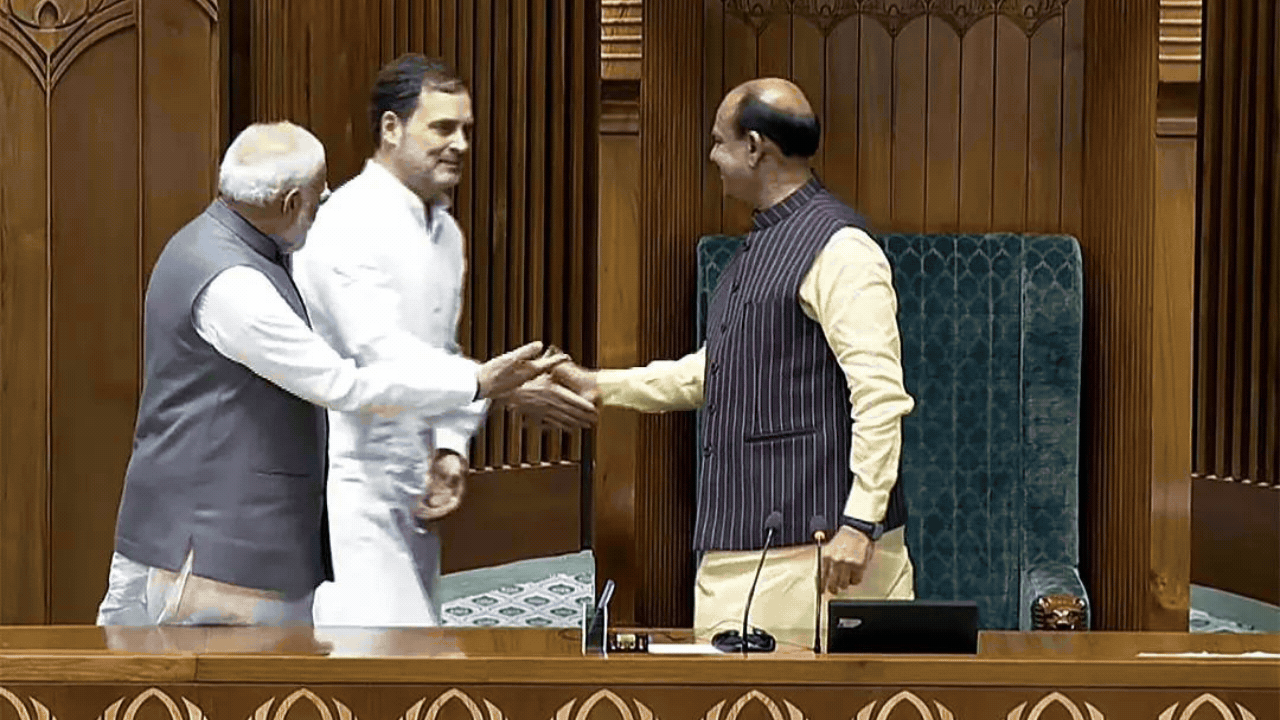Modi 3.0 starts on winning note in Lok Sabha, but opposition makes its presence felt

NEW DELHI: PM Modi-led NDA government on Wednesday won the first battle of numbers on the floor of 18th Lok Sabha as ruling NDA candidate Om Birla was re-elected Speaker with a voice vote. Opposition’s INDIA bloc, despite all its posturing, did not press for division of votes – a candid admission of lack of numbers on their side.
Ever since the results were declared on June 4, there have been talks of change in the character of the 18th Lok Sabha.
AIMIM MP Asaduddin Owaisi reflected the opinion of many in the opposition camp when he said today that the ruing BJP will not be able to “steamroll” the opposition as the character of the House has changed in new Lok Sabha. With the BJP failing to secure a majority on its own, the number dynamics in the Lower House has indeed changed. Prime Minister Modi is now dependent on allies for the survival of his government. But has that made any perceptible change in the way Modi 3.0 has functioned since it took oath on June 9? Well, the answer is both “yes” and “no.”
Election of Speaker
The election of Om Birla as Speaker of Lok Sabha had the stamp of authority which was trademark of both Modi 1.0 and Modi 2.0. With the firm support of allies, the government did not let opposition dictate terms on Speaker’s election and refused to enter into any negotiations over the choice of deputy speaker. While the opposition wanted a commitment on deputy speaker’s post, the government sent out a clear message: “First, you support Speaker’s election, and after that, we can discuss about the Deputy Speaker.” The stalemate ensured an election for Lok Sabha Speaker – something that had happened only three times till now – in 1952, 1967, and 1976.
The Emergency attack
The invoking of “dark days of Emergency” by Prime Minister Modi and other top NDA leaders ahead of Parliament session was another signature BJP strategy – seen several times in the last 10 years of NDA rule – to not just put the opposition under pressure but also to isolate Congress within the INDIA bloc. With the Congress and INDIA bloc leaders carrying forward their poll campaign of “Save Constitution” to put the BJP on the backfoot, saffron party’s “Emergency” counter attack was a well-planned move to keep the narrative around Constitution but with a different take. With Speaker Om Birla joining the government in attacking Emergency, the opposition’s hopes of any perceptible change in government’s functioning due to reduced numbers – may remain just that.
BJP stamp on government
When PM Modi took oath for a record third term in office, the belief was that allies, especially Chandrababu Naidu’s TDP and Nitish Kumar’s JD(U) would walk away with plum portfolios in bargain for their crucial support to run Modi 3.0. There were also reports that TDP wanted the Speaker’s post. However, that did not happen. The BJP has not yielded too much of space to allies and has kept almost all the important portfolios with itself.
Continuity vs Change
Modi 3.0 has been marked by continuity, unlike Modi 2.0 when change was perhaps the only constant. Prime Minister Modi has retained most of his top ministers and even his top officers. He has also not changed the portfolios of key ministers. The choice of Speaker also signalled this spirit of continuity. This is in contrast to 2019, when Prime Minister Modi had returned to power with an overwhelming majority of 303 seats, and his Cabinet and council of ministers saw several changes. In 2019, the BJP selected Om Birla as Speaker replacing Sumitra Mahajan who presided over Lok Sabha during Modi 1.0.
Balance on policy issues
And while the BJP imprint has been strong till now, the saffron party will have to tread a cautious path when it will come to policies of Modi 3.0. Even before the countours of government was finalised, allies went public with their reservations on the Agniveer scheme, which was a flagship policy of Modi 2.0. The caste census is another issue on which the allies would have a different perspective. During campaigning, the BJP had teared into the Congress over reservations given to Muslims in Karnataka. However, in TDP, the BJP has an ally which openly supports the idea and is all set to implement it in Andhra Pradesh.
Working with the ‘Shehzada’
Prime Minister Modi may have avoided taking the name of Rahul Gandhi in the last 10 years and referred to the Congress leader as Shehzada. However, the changed number dynamics has now made the former Congress chief an integral part of government’s functioning for the first time. We saw the first glimpse of this today when Rahul accompanied PM Modi to escort Om Birla to the Speaker’s chair. Also, as leader of the opposition, Rahul Gandhi will be part of several parliamentary bodies and panels for key appointments that are headed by Prime Minister. Rahul may still not have a say in their functioning, but he will be privy to all the discussions.
While the BJP wants to drive home the point that Modi 3.0 is firmly in the saddle and it is business as usual, just like the first two terms of the Prime Minister, the opposition knows that Modi government is now completely dependent on crucial support provided by two key allies. The upcoming Budget may see some incentives, extra grants or even a special category status for Chandrababu Naidu’s Andhra Pradesh and Nitish Kumar’s Bihar. For Naidu and Nitish, these perks would be of far greater importance than any possible leverage at Centre. As long as the BJP manages to keep the NDA intact, it can afford to ride roughshod over opposition and provide glimpses of the authority it wielded in the last 10 years.
